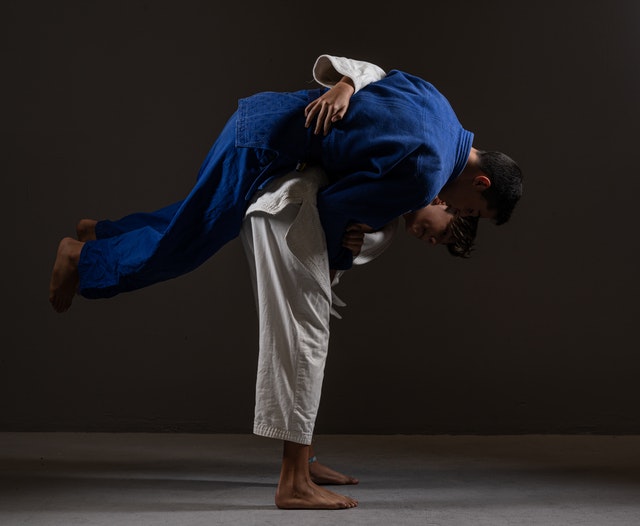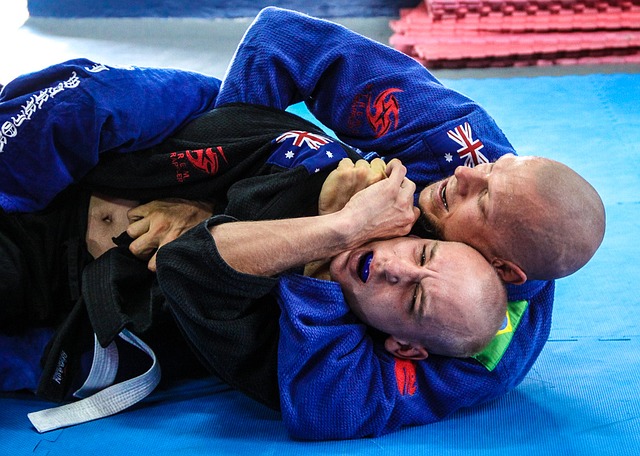BJJ vs Judo in 2025 - The Ultimate Comparison
BJJ and Judo are two grappling arts that are very similar and they share many same techniques. This is because BJJ has its origins in Judo which makes these two arts almost the same on paper. But they differ a lot in various aspects, notably when it comes to rules, emphasis, and even techniques.
Judo is an older art of the two that puts more emphasis on standup grappling. The goal in judo is to use powerful trips and throws to take the opponent down to the ground. Once there, judoka use pins and various chokes and locks to subdue the opponent. But overall, fighting on the ground is not that important. BJJ differs a lot here as, although it uses judo as a base, focuses much more on ground fighting and using various chokes and joint locks.
Still, there is a lot more to BJJ vs Judo. Stay with us to find out how they differ when it comes to self-defense, MMA, or which one would win in a street fight.
BJJ vs Judo- What are the main differences?
Finding out which one is better, BJJ or Judo is not an easy task. First, we must focus on finding out how they differ from one another so we can have a base for upcoming comparisons. Here is all you need to know about BJJ and Judo:
History and Origins
Judo is a modern martial art founded by Kano Jigoro in 1882 that focuses on grappling. With its origins coming from jujutsu, judo focuses on the standup aspect where fighters learn various throws and trips. Once the fight hits the ground, they use pins, chokes, and joint locks to subdue the opponent. The art includes striking on paper but its students practice it just in a pre-arranged form called “kata”.
BJJ is a Brazilian art founded by the famous Gracie family in the 1920s. It all started when the judoka Mitsuyo Maeda came to Brazil to teach judo and spread the sport. His students, Carlos and Helio Gracie would use judo as a base to create their own style that focuses more on ground fighting. BJJ reached its stardom with the birth of modern MMA in the early 90s where it plays a key role.
Emphasis and Techniques
On paper, Judo is a grappling art that will teach you how to grapple in the standup and fight on the ground. But in reality, judo is all about getting a strong grip and executing powerful throws and trips. Although it teaches you ground fighting skills like chokes and joint locks, the standup aspect is far more important. This is mainly because, in modern competition, throws bring you far more points.
BJJ, on the other side, goes the other way around. The emphasis of the art is on ground fighting and learning positions, sweeps, escapes, chokes, and joint locks. Since each fight begins on the feet, students learn how to apply judo throws and trips. But the art truly shines once the fight goes to the ground where BJJ fighters are almost unbeatable.
Rules of Competition
Judo in the form of sport has been around since 1899, and it has made its debut at the Olympic Games in 1964. The Judo rules may look complex at first sight. But, they are actually very simple and here is all you need to know about them:
- Judo includes seven weight classes for both men and women
- The matches usually last 3 minutes. If both judoka have equal points, they proceed to fight for three extra minutes by the “Golden Score” rule. The first one to win a point wins a match.
- Judokas score points by executing various throws. The main goal is to earn an “ippon” which is one full point that is enough to win a match. A single powerful throw can secure you an ippon and a win.
- Judoka can also score half a point or “waza-ari” by executing less powerful throws or when they pin the opponent on the ground.
BJJ, on the other side, differs a lot when it comes to rules which gives you a great insight into why these two arts differ so much. It’s important to know that there are many BJJ organizations and rules may differ between them. For the purpose of this article, we will explain IBJJF rules:
- The length of the matches differs between the rank levels. They usually last 5 min (white belts), 7 min (purple belts), 8 min (brown belts), and 10 min (black belts).
- Fighters get 2 points for taking the opponent down using throws or securing a knee on the belly position.
- They get 3 points only when they pass the guard.
- They can win 4 points when they get the full mount or back mount position.
- The main goal is to win a match via submission.

BJJ vs Judo - What are the similarities?
Since BJJ has its origins in Judo, it’s normal that these two are very similar to some extent. Here is a brief look into key similarities between BJJ and Judo you should all be aware of:
- Students in both arts must wear a Gi uniform that includes a cotton jacket and pants. They must wear it both in training and competition, except for BJJ fighters who train in “no-gi” form.
- The grappling exchange in both arts begins on the feet where the main goal is to take the opponent down.
- Fighters from both arts use Judo throws and trips to take the fight to the ground.
- Some popular Judo throws in BJJ are “O Soto Gari”, “O Goshi”, and many, many others.
- BJJ and Judo share many similar submissions like armlocks and chokes. The most popular armlocks are the ones in which they attack the elbow like an armbar. And a judo choke we often see in BJJ is the arm triangle.
BJJ vs Judo - Which one is better for self-defense?
Both of these arts are great for self-defense and will train you for real fighting. These are the only arts that allow you to beat the bigger and stronger opponent by focusing on leverage and technic. BJJ and Judo techniques work no matter how big the opponent is. But still, we must say BJJ is better since it is more versatile.
BJJ will teach you how to use most throws and trips you can find in Judo. You will know how to close the distance, secure a strong grip and take the opponent down. This where BJJ shines as its focus is on ground fighting where most average people don’t have clue how to fight. An average person has no chance of surviving on the ground with skilled BJJ fighters on top of them.
On paper, every person has a chance to land a strike on the feet. But what BJJ teaches you is how to time a level change to go under the punch for instance, and score a takedown. This is what makes BJJ great for street fighting as it is very hard to stop grapplers from doing what they know best.
BJJ is also great as it allows you to subdue the opponent without hurting them much. The last thing you need in street fighting is to hurt the opponent and go to a police station to further explain your actions.
Don’t get us wrong here, Judo is also good for self-defense, but slightly less practical than BJJ. This is mainly due to the lack of advanced ground fighting skills. But on the other side, locks and chokes you learn in Judo are often enough to subdue the average person.
BJJ vs Judo- Which one is better for MMA?
Although both arts work well in MMA, we must say that BJJ plays a much bigger role in modern MMA fighting. This is mainly because it fits better into the concept of MMA that puts a lot of emphasis on ground fighting. Knowing how to use or defend against chokes and joint locks or use sweeps and escapes is crucial.
In some way, we can even say you can’t survive an MMA match without BJJ skills. You can, to some extend if you are facing strikers. But sooner or later, you will find yourself waking up in the middle of the cage asking what the hell happened. And let’s not forget that BJJ has been a part of modern MMA since day one.
In the early days, BJJ legend Royce Gracie dominated the early UFC events by submitting fighters from other styles. He beat many boxers like Art Jimmerson, wrestlers, and kickboxers to show the world that BJJ is the best fighting style. If we look at the stats, over 60% of all UFC fights in 1994 ended in a submission, which shows you how dominant BJJ was.
Of course, this number has dropped over the years as fighters started cross-training and they became good at defending. But BJJ is still a crucial part of MMA as submissions and ground control are more important than ever. Here are some of the best MMA fighters who come from BJJ:
- Charles Oliveira
- Ronaldo Souza
- Brian Ortega
On the other side, there were also many great MMA fighters who had a good Judo base. The most famous is Ronda Rousey whose judo throws and arm locks were legendary.

Can a Judo fighter beat a BJJ fighter in a street match?
Of course, judokas have all the tools and weapons to beat BJJ fighters in a street fight. In fact, most BJJ fighters would have a hard time dealing with judokas. And the reason for this is very simple.
As said earlier, judo is a grappling art that puts a lot of emphasis on standup and executing throws and trips. This means they all have a great balance, core strength, and more tools to keep the fight standing. The only way BJJ fighters can beat judokas is by taking them down first, which would be really hard. In most cases, judokas would be the ones dictating the place of the fight, not BJJ fighters.
But let’s look back in history and real BJJ vs Judo street fight matches that took place. Gracie family members fought against many great Judokas like Yukio Kato and Masahiko Kimura. Here are some of the results:
- (1950) Helio Gracie vs. Yukio Kato– Gracie won this fight by choking Kato out unconscious.
- (1951) Helio Gracie vs Masahiko Kimura– the Japanese judoka had around 40–50 pounds weight advantage in this fight. He won the fight by breaking Gracie’s arm with a shoulder lock after 12 minutes of fighting.
- Royce Gracie vs Remco Pardoel - Royce won this fight by using his gi to sink in the lapel choke after 1:31 minutes of fighting.
- Royce Gracie vs Hidehiko Yoshida - these two have fought two times. In the first meeting, Yoshida won by setting up a gi-choke which forced the referee to stop the match. But the Gracie’s never acknowledged this loss as Royce said he was still conscious and fighting back. They would meet once again in 2003 in a 10-minute fight which ended as a draw, despite Royce dominating the fight.
BJJ vs Judo - Which one is better for kids?
If you want to enroll your kids in martial arts classes then both BJJ and Judo are great choices. Above all, both arts will teach them all about respect, honor, and how vital it is to work hard to achieve your goals. They won’t earn anything in training without putting in a lot of work and leaving it all on the mats.
Judo has always been a very popular martial art for kids as it focuses on both mental and physical aspects. It will teach your child great self-defense skills and help to grow into a person with good values. But above all, Judo training is very safe as the art doesn’t include any striking that may take a toll on kids’ bodies in the long run. Yes, powerful throws could be painful at times, but the risk of injuries is really low.
In recent years, BJJ has also become very popular for kids who have a ton of fun rolling around on the mats. It is a really playful art that will teach them all about grappling in the standup and how to fight on the ground. It is a very complex art that includes hundreds of techniques and kids must learn it at a very slow pace.
This is great because it will help them socialize, develop good self-defense skills and build strong mental toughness. Like Judo, BJJ also doesn’t include any striking and the risk of injuries is really low. Although some chokes and joint locks may look scary at first sight, training is very safe.
BJJ vs. Judo for law enforcement
There are a lot of police officers around the world who are black belts in arts like Judo and BJJ. In some countries, these two arts are even a part of police training where they learn how to neutralize the suspect.
You see, Police officers have to deal with a wide range of situations and persons on the street on a daily basis. Still, they all must stay calm and keep the emotions low to make the right decision. They can achieve this through Judo training for instance, which focuses on both mental and physical aspects of fighting.
Judo is great for Police officers since they often put their hands on people. If the suspect is resisting, then we are talking about grabbing and pulling at close range. These exchanges could be very intense at times but this is also where judo skills work the best. Judo training improves your balance, strength, teaches how to secure a grip, hold your ground and throw the suspect down.
Once there, Police Officers use various pins or joint locks to neutralize the attacker. It even doesn’t matter if the suspect is bigger and stronger. Judo is all about leverage and technic and you can’t use sheer power to defend against judo or BJJ techniques. You have to train judo for many years to know how to stop takedowns.
Of course, police officers can use punches or pepper spray in these situations. But having judo skills allows them to keep both parties safe and without any injuries.

Final Thoughts
As we have seen in this article, BJJ and Judo may look similar at first sight, but are much different when you take a closer look. However, they share many benefits as both are great for self-defense, MMA and are safe enough for kids. Which one is better is not a fair question as both arts have many pros and cons.
BJJ is far better when it comes to ground fighting and using various chokes and joint locks to subdue the opponent. You should choose it over Judo if you have any plan of fighting in MMA later as BJJ plays a big role in MMA fighting. When it comes to self-defense, kids classes or how much fun you can have in training, we must say both of these arts are the same.
Overall, you won’t make a mistake choosing any of the two no matter what you want to achieve with your training.
